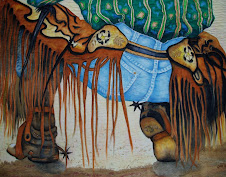Stitching Atop Stabilizer isn't all that tricky but it does require you sample test your tension as it will possibly need be a little different than when quilting. I begin with somewhat graceful curved back and forth stitching trying to follow obvious body contour. As part of planning ahead, I am not stitching white all the way to the edge of his body. I will want to 'quilt' in some of the surrounding background and then later quilt in white at the edges of the fox's body so the fur will set IN FRONT of the background. You may be saying.. WHY didn't she just quilt the background first? 2 reasons.... the white work was done on a stabilizer before the quilt sandwich but as importantly, planned disproportioned quilting density suggests working from center to outside will give you better surface results such for your quilt to hang straight...be flat. So the body of the fox is stitched and I will want to make sure it is plenty flat before I make the quilt sandwich. This one wasn't distorted much at all, but a light water mist, and pinning to the ironing board to air dry will give me a little break and make for a perfectly flat surface on which to later quilt. Interesting fact: The Arctic fox is one of natures adaptation achievements. His camoflage is absence of color in the winter. He is brown in warm months. Click on photo for close up.
Monday, December 19, 2011
Subscribe to:
Post Comments (Atom)








2 comments:
Hi Patt,
I always love seeing your process when quilting. One question: how did you get the definition between front leg and back leg or jaw line etc.... For me that is always a challenge to get it to be realistic. Love the Artic Fox!
LauraT
I can say what I did and hope that helps.. First I began by painting a subtle value change at intersections of 'body parts.' While the light direction is not strong, the light source is coming from slightly above on the viewers right. That makes the back leg underneath the fox slightly darker...and adds a slight value change where the jaw line resides above the chest.
By using a 40 wt thread... (not to skinny, not too fat), the paint values underneath stitching tend to hold up for viewers. If it doesn't, there's nothing to say you can't add pigment after the fact.
Post a Comment